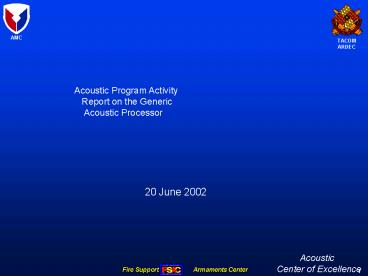moa
1 / 9
Title: moa
1
Acoustic Program Activity Report on the
Generic Acoustic Processor
20 June 2002
Acoustic Center of Excellence
2
Review of Original Proposal
Title Miniaturized Acoustic/Seismic
Sensor Pre-Processing Electronics
Technical Description Miniaturized electronics
package performs multi-channel signal
conditioning, A/D, FFT, generic feature
extraction and compression for transmission comm
link. Master control unit receives information
from multiple units and performs all custom
classification, counting, tracking or other
system algorithm solutions.
Acoustic/Seismic Arrays
Master Control Unit
Core Electronics Module
Preprocessing, A/D, FFT, Feature Extraction,
Compression
Add-on Comm
Benefits - Universal sensor electronics for
many applications, accelerates system solutions.
- Pre-processing with compression achieves low
communications load. - Use as low cost data
acquisition system accelerates system
developments. - Avoids custom algorithm node
level solution for each system application. -
Obviates the need for comm between nodes for data
sharing, thus reducing comm load while
improving overall system reliability. - System
software solution easy to manage and upgrade at
master control unit. - Concept amenable to high
performance system level beamforming approaches
3
Current Program Goals
- Develop, evaluate, and test compression and
innovative - messaging/communications designs to minimize the
acoustic - data transmitted by an acoustic array.
- Determine generic processing functions that can
be - performed up front which reduce the ultimate
amount of - information which must be transmitted, yet still
allow - a wide range of algorithm implementations at the
master. - - Overall approach must operate on go-to-war
radio systems. - Deliver at the end of first year effort a
functional design, - tested in a Matlab environment and which
quantifies the - overall compression gain realized with actual
recorded data.
Acoustic Center of Excellence
4
Recent In-house Accomplishments
- Designed an innovative compression scheme
- whereby the small differences between information
- recorded at each microphone is exploited.
- Defined the design for a pre-processing front
end - which extracts the essential bandwidth and
signature - content of features, allowing the acoustic array
to - significantly adjust and reduce its communication
of - information in concert with the prevailing
signature - activity. In cases where only one target is
present or - signature activity is low, very high compression
ratios - can be achieved.
Acoustic Center of Excellence
5
Source Data Compression Algorithm Development
- Compute difference between corresponding samples
in time - Find and Record the middle value
- Subtract this value from remaining columns
- Create Codeword with Reduced Representation
Acoustic Center of Excellence
6
Source Data Compression Algorithm Development
Compression Code Word Format
Current Compression Ratios
Acoustic Center of Excellence
7
Pre-Processing Front End
10 bit dynamic range X 5 channels X 500 1/2Hz
frequency bins 25Kbps
Magnitude
Noise Floor
FFT
Phase 10 bit dynamic range X 5
channels X 500 1/2Hz frequency bins
25Kbps
Assuming 5 channel solution, total data rate
50Kbps, compared to 80Kbps baseline, but this is
for each of 500 total frequency bins. In the
real world, only 100 or so bins of target
features are anticipated assuming average target
activity. Assuming an average of 100 bins, a
compression ratio of 8 1 is realistically
achievable.
Acoustic Center of Excellence
8
High Performance Beamforming Using Sparse
Acoustic Arrays
The generic acoustic sensor outputs real time
information from multiple nodes which can be
used to form unique system level beamforming
arrays. The use of widely spaced sparse arrays
are inherently much more powerful than small
arrays, but have spatial aliasing problems. The
construction of multiple sparse arrays using an
individual mic on a sensor array in combination
with similarly located mics on other remotely
spaced arrays allows a potential quantum leap in
beamforming and multiple target tracking
performance. Recent tests on coherence in
sparce arrays indicates separations of 100 to
200m is practical. Further testing will be
performed as part of Phase II SBIR.
Acoustic Center of Excellence
9
Acoustic Information Transmitter
- Current designs for data compression will
achieve - close to 4 to 1 compression (further compression
is - within reach).
- A pre-processing front end which extracts
essential - feature information may contribute another 81 or
more - in the real world (on average) which totals 321
net gain - or 2500 bps compared to baseline 80Kbps. This is
- very amenable to existing fieldable radios.
- The approach is especially attractive for
exploiting - high performance system level beamforming.
Acoustic Center of Excellence































